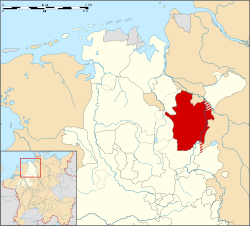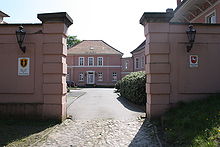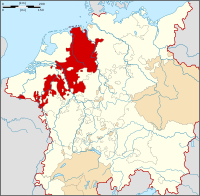- County of Hoya
-
Grafschaft Hoya redirects here. For the present administrative unit, see Grafschaft Hoya (Samtgemeinde).
County of Hoya
Grafschaft Hoya (de)State of the Holy Roman Empire ← 
1202–1582  →
→Coat of arms
County of Hoya (in yellow) about 1400 Capital Hoya
NienburgGovernment County Historical era Middle Ages - Henry I Count of Hoya 1202 - Partitioned between
Hoya and Nienburg1345 - Reunited under
Jobst I of Nienburg1497 - Joined Lower
Rhenish–West-
phalian Circle1500 - Count Jobst II turned
Protestant1523 - Death of Otto VIII 1582 - Part of Prussia 1866 The County of Hoya (German: Grafschaft Hoya) was a state of the Holy Roman Empire, located in the present German state of Lower Saxony. It was centered on the town of Hoya on the middle Weser river, between Bremen and Nienburg; the area now belongs to the districts of Nienburg and Diepholz. The largest city of the county was Nienburg.
Contents
Geography
As of 1582, Hoya was bordered by (from the north, clockwise): The City of Bremen, the Archbishopric of Bremen, the Bishopric of Verden, the Lüneburg and Calenberg subdivisions of Brunswick-Lüneburg, the Bishopric of Minden, the County of Diepholz, the Bishopric of Münster, and the County of Oldenburg.
History
A first Count Henry at Hoya in Saxony appeared as a liensman of Archbishop Hartwig II of Bremen in 1202. He rivaled with the local Hodenberg noble family at Hodenhagen Castle; their estates on the Weser were gradually acquired by Count Henry and his descendants until 1313. The acquisition of Nienburg led to a long-time conflict with the Bishops of Minden, who suspiciously eyed the steep rise of their comital neighbours.
In 1345 the brothers Gerhard III and John II of Hoya, divided the county among themselves; when the elder branch of Gerhard at Hoya became extinct in 1497, the territories were re-unified under John's descendant Count Jobst I residing at Nienburg. In the 16th century, the counts came under pressure of the mighty Dukes of Brunswick-Lüneburg, who in 1512 occupied their erstates.
After the last count of Hoya died without sons in 1582, the territory was divided between the Lüneburg line of the Duchy of Brunswick-Lüneburg, the Calenberg line of the same duchy, and the Landgraviate of Hesse-Kassel (or Hesse-Cassel). The Counts of Hoya already had to recognize the Welf dukes of Brunswick-Lüneburg as liege lords in 1512.
After the Austro-Prussian War of 1866, the area together with the Kingdom of Hanover was annexed by Prussia.
Counts of Hoya
- Henry I 1202-1235
- Henry II 1235-1290 Heinrich II.
- Otto II 1290-1324 Otto II.
- Gerhard III 1324-1345 jointly with his brother
- John II
Hoya-Hoya
- Gerhard III 1345-1383 Gerhard III.
- Otto III 1383-1428
- Otto V 1428-1451
- Otto VII 1451-1497
Hoya-Nienburg
- John II 1345-1377
- Eric I 1377-1426
- John V 1426-1466
- Jobst I 1466-1497
- Jobst I 1497-1507
- Jobst II 1507-1545
- Albert II 1545-1563
- Otto VIII 1563-1582
 Lower Rhenish–Westphalian Circle (1500–1806) of the Holy Roman Empire
Lower Rhenish–Westphalian Circle (1500–1806) of the Holy Roman EmpireEcclesiastical Prelates Secular Counts
and lordsfrom 1500Bentheim · Bronkhorst (until 1719) · Diepholz · East Frisia (until 1667) · Horne3 (until 1614) · Hoya · Lingen3 · Lippe · Manderscheid (until 1546) · Moers (until 1541) · Nassau (Diez · Hadamar · Dillenburg (until 1664)) · Oldenburg (until 1777) · Pyrmont · Ravensberg3 · Reichenstein · Rietberg · Salm-Reifferscheid · Sayn · Schaumburg · Tecklenburg · Virneburg · Wied · Winneburg and Beilstein · Zimerauff?from 1792Anholt · Blankenheim and Gerolstein · Gemen · Gimborn · Gronsfeld · Hallermund · Holzapfel · Kerpen-Lommersum · Myllendonk · Reckheim · Schleiden · Wickrath · Wittemstatus
uncertainCities 1 from 1792. 2 until 1792. 3 without Reichstag seat. ? status uncertain. Categories:- Former countries in Europe
- States of the Holy Roman Empire
- States and territories established in 1202
- States and territories disestablished in 1582
- History of territories in Germany ruled by a secular sovereign
- Counties of the Holy Roman Empire
- 1582 disestablishments
- History of Lower Saxony
- Lower Rhenish-Westphalian Circle
Wikimedia Foundation. 2010.




